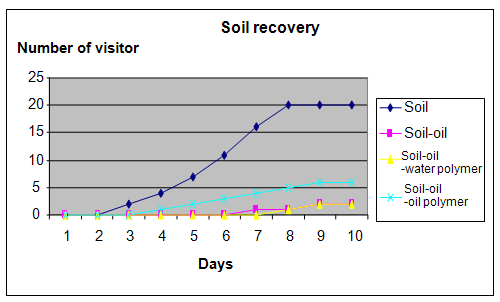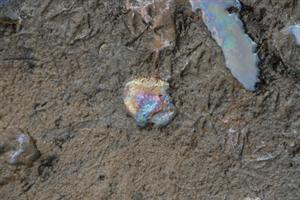| Complexity level: | 8 |
| Project cost ($): | 70 |
| Time required: | 1 day to prepare, 10 days for the science project experiment |
| Material availability: | Easily found |
| Safety concerns: | Basic safety requirements. Discard the motor oil properly. Do not allow the motor oil to come into contact with bare skin. > |
Hypothesis
Oil absorbing polymers can effectively rehabilitate soil contaminated with motor oil and render the soil suitable for growth. Seeds will geminate in the rehabilitated soil that has been treated with oil absorbing polymers.
Overview
Soil contamination
Soil contamination is the pollution of soil by pollutants such as hydrocarbons, heavy metals, pesticides and solvents. The sources of these contaminants are numerous – and include, for example, the use of pesticides, discharge of industrial waste, leakage from storage tanks, the dumping of fuel , land-fill wastes and many more.
Soil contamination poses many health risks to people, either through direct contact with the soil or the inhalation of the evaporated gases. However the biggest problem is the contamination of ground water that is eventually consumed by us. The health risks posed by soil contamination depends on the type of contaminant involved and the vulnerability of the affected population.
Over-exposure to lead, chromium, heavy metal, petroleum and pesticides that are known to be carcinogenic, leads to very serious, and usually chronic, health problems. For example, high doses of benzene exposure is known to result in increased incidences of leukemia. Mercury is known to increase the chances of damage to our kidneys.
Scientific Terms
Materials
The materials required for this science fair project:
- 80 green bean seeds
- 4 pots
- enough soil for the 4 pots
- 1 bottle of motor oil
- 1 packet of oil absorbing polymers
- 1 packet of water absorbing polymers
- water
- A spade
- a black marker pen
Procedure
1. For this science fair project, the independent variable is the soil content – normal soil, soil contaminated by motor oil, soil contaminated with motor oil but treated with the water absorbing polymer and soil contaminated with motor oil but treated with the oil absorbing polymer. The dependent variable is the number of green beans that germinate. This is determined by counting the number of seeds that geminate. The constants (control variables) are the size of the pot, the number of seeds in each pot, the amount of water, the amount of sunlight and the room temperature.
2. Four pots are labeled “soil”, “soil-oil”, “soil-oil-water polymer” and “soil-oil-oil polymer” accordingly. The soil in the pots is prepared as follows :
a. Soil : The pot is filled with soil only
b. Soil – oil : The soil is mixed with 100 ml of motor oil before filling the pot
c. Soil – oil- water polymer : The soil is mixed with 100 ml of motor oil and the water absorbing polymer is added to the soil
d. Soil - oil – oil polymer : The soil is mixed with 100 ml of motor oil and the oil absorbing polymer is added
Ensure that each sample is mixed and stirred thoroughly.
3. 20 green beans are placed in each of the 4 pots that were prepared as explained above. The beans were spread out at least 1 cm apart from each another.
4. The 4 pots are watered once a day and placed where they are able to receive enough sunlight and air in order to germinate.
5. The pots are observed for the next 10 days to ascertain the number of germinated beans and the results are recorded in the table given below.

Results
The results showed that the pot without any oil had the most number of beans that germinated, followed by the pot with motor oil and the oil absorbing polymer.
|
Number of green beans germinated |
||||||||||
|
Day 1 |
2 |
3 |
4 |
5 |
6 |
7 |
8 |
9 |
10 |
|
|
Soil |
0 |
0 |
2 |
4 |
7 |
11 |
16 |
20 |
20 |
20 |
|
Soil-oil |
0 |
0 |
0 |
0 |
0 |
0 |
1 |
1 |
2 |
2 |
|
Soil-oil-water polymer |
0 |
0 |
0 |
0 |
0 |
0 |
0 |
1 |
2 |
2 |
|
Soil-oil-oil polymer |
0 |
0 |
0 |
1 |
2 |
3 |
4 |
5 |
6 |
6 |
The graph below represents the results of our science project experiment.

Conclusion
Our hypothesis has been proven to be true. Oil absorbing polymers can effectively rehabilitate soil contaminated with motor oil and render the soil suitable for growth. Green beans will geminate in the rehabilitated soil that has been treated with oil absorbing polymers.
The beans in the contaminated soil had difficulty germinating. Using the oil absorbing polymer, we were able to remove some of the motor oil from the soil, and this resulted in more beans germinating.
The presence of contaminants also affects our ecosystem because the soil chemistry and pH is altered. These changes will eventually affect the population of flora and fauna in the region. Efforts including the excavation and aeration of the soil, are being made to rectify this problem. Microbials are also used to digest certain organic materials in the soil, to speed up the rehabilitation process.
Also consider
Try to repeat this science fair project this time using different types of contaminants like pesticides or grease.
The science project experiment can be repeated to monitor the growth rate of certain species of plants in contaminated soil, to ascertain which species are more hardy
References
Soil contamination - http://en.wikipedia.org/wiki/Soil_contamination
Soil contamination - http://www.sciencedaily.com/articles/s/soil_contamination.htm

